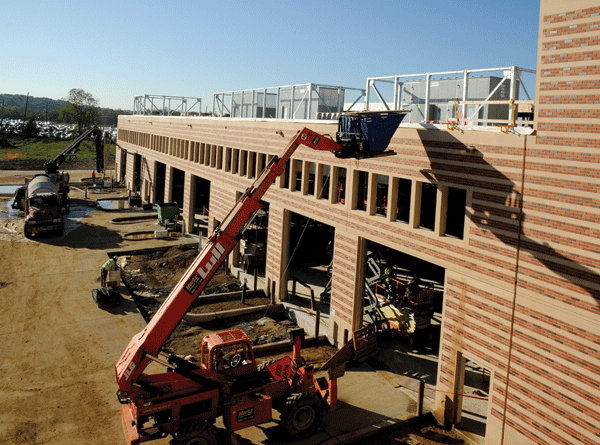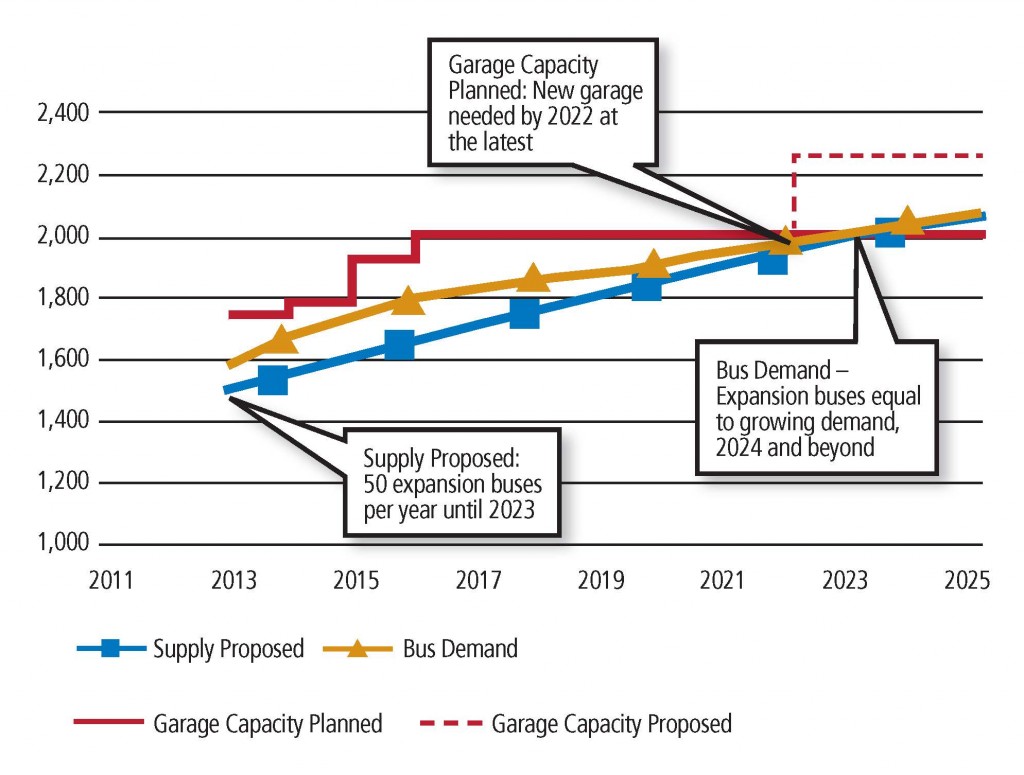Bus Fleet Expansion
Metrobus needs to accommodate growth  in demand for bus service. Simultaneously, service effectiveness and reliability are suffering due to increasing traffic congestion. In order to meet this challenge, Metro requires 400 new buses by 2025 in addition to those needed for service on the Priority Corridor Network (PCN). Between PCN implementation and service expansion on “Emerging Corridors”, a bus fleet of 2,060 is required by 2025. To support this fleet, an additional 250-space bus garage will be needed along with heavy overhaul capacity expansion from 100 to 150 buses/year.
in demand for bus service. Simultaneously, service effectiveness and reliability are suffering due to increasing traffic congestion. In order to meet this challenge, Metro requires 400 new buses by 2025 in addition to those needed for service on the Priority Corridor Network (PCN). Between PCN implementation and service expansion on “Emerging Corridors”, a bus fleet of 2,060 is required by 2025. To support this fleet, an additional 250-space bus garage will be needed along with heavy overhaul capacity expansion from 100 to 150 buses/year.
Purpose and Need
Metro faces dual challenges of growing demand for bus transit and increasing traffic congestion, resulting in slower trips, overcrowding, and less reliable service. In order to achieve and maintain a state of good operations in the face of these challenges Metrobus needs an expanded bus fleet and increased maintenance and storage capacity. An increase in fleet size from 1,505 in 2013 to 2,060 in 2025 would relieve crowding, increase operational efficiencies and allow Metro to meet the ever-growing demand for bus transit along the Priority Corridor Network and the next tier of “Emerging Corridors”. To enable such an increase, Metro would also need one additional bus storage and maintenance facility, as well as added heavy maintenance capacity.
Benefits
- Provides customers with an enhanced bus transit experience: faster, safer, more comfortable
- Increases operational efficiencies and on-time performance
- Enhances surface transit to relieve Metrorail core capacity
- Allows Metrobus to maintain existing levels of service, which is constantly threatened by ever-increasing traffic congestion on local roads
- Continues investment in improved bus maintenance practices
- Provides service to meet growing demand: up to 40,000 additional bus trips per day
Considerations
- Primary challenge to meet emerging bus growth is the lack of funding for new buses.
- Secondary challenge is meeting the increased operating costs that will result from operating and maintaining the additional buses.
- Despite benefits of bus transit, bus facilities are notoriously hard to site due to traffic, noise and air quality concerns raised by neighbors.
- Expansion of the fleet can begin immediately: expansion of heavy overhaul capacity is required when expansion buses reach mid-life, starting around 2020.
- Planned garage capacity increases can accommodate many of the buses needed by 2025 but not all of them.
- Principles of efficient operation dictate that buses be housed in garages located near the routes served, meaning:
- Excess capacity in one garage does not imply new facilities are not warranted elsewhere and
- Growing demand for bus service in the urban core cannot be efficiently served by new facilities located in suburban areas.
- Best practices in bus maintenance indicate 250 buses is the optimal storage capacity of a new bus facility.
- New garages will need to include maintenance facilities for an expanded articulated bus fleet.
Status of Ongoing Projects
- Royal Street garage will become unusable by 2016 due to height restrictions and taller dimensions of newer buses.
- Cinder Bed Road garage is designed and funded to replace Royal Street and is now moving into implementation.
- Implementation of Southern Avenue Bus Garage replacement is now commencing.
- Metro is actively pursuing options for replacement, rehab or consolidation of Northern and Western bus garages.
FY2014-2019 Investments
These investments are already included and funded in Metro’s current six-year CIP.
- Purchasing 100 expansion buses
- Adding bus garage capacity
- Implementing improvements on additional corridors
- Evaluating additional corridors for improvements
Total – $85M
Note: these planned investments are also enumerated in the Metrobus Priority Corridor Network description
Order of Magnitude Cost Estimate
$450 million (2012$)
- $300 million: bus fleet expansion ($720k per bus)
- $50 million: bus overhaul capacity expansion, to 150 buses per year
- $100 million: new, 250-space bus garage
Timeline
For more information:
Download both the full Momentum plan and the Executive Summary.
Regional support is important to making Momentum a reality! A number of regional stakeholders have already endorsed Momentum. Please sign on and add your name to endorse Momentum and send the message that public transit is vital to the National Capital Region.




I am not sure if it is a standard, but having a bus stop every block slows down bus services requiring more buses to maintain the same headway. Can anything be done to reduce the number of bus stops?
@Reuben
Reuben, Metro’s bus stop consolidation guidelines and plan were described on this site back in 2011: https://planitmetro.com/2011/01/03/metrobus-bus-stop-consolidation-program/
@Michael
That is great to hear. I look forward to the 3ABEY bus stop consolidation.